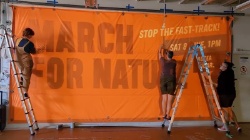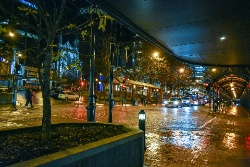New Zealand Mountain Safety Council (NZMSC)
New Zealand Mountain Safety Council (NZMSC)
For the second time in 2 weeks, rescue services have been called out to attend large avalanche events triggered by casual backcountry users.
The Mountain Safety Council advises skiers, snowboarders, climbers and trampers to avoid backcountry travel in regions with HIGH danger until further notice. Up-to-date details about avalanche conditions can be found at the Mountain Safety Council public avalanche information advisory website www.avalanche.net.nz.
Warnings of HIGH avalanche danger in the backcountry (areas outside of ski field boundaries) have been in place for the last two weeks. The Mountain Safety Council avalanche forecasters continue to hold the danger rating at this level. HIGH avalanche danger designation is defined as:
1. The
snowpack is weakly bonded in most places.
2. Natural and
human triggered avalanches are likely.
3. Backcountry
skiing and travel should be restricted to low angled slopes;
areas at the bottom of slopes may be hazardous.
The Mountain Safety Council urges everyone to seek advice regarding the level of avalanche danger before heading out of patrolled ski field boundaries into the backcountry. Knowledge of terrain, current weather and snowpack conditions are basic necessities. The Mountain Safety Council avalanche advisory can be found at www.avalanche.net.nz and is updated daily. Local ski patrols and Guiding companies can also offer accurate and up-to-date information.
Basic avalanche safety equipment consisting of an avalanche transceiver, shovel, and probe should be carried by everyone in a group heading outside of ski field boundaries into the back country. Regular practice with all this equipment will ensure people are well prepared in an emergency rescue situation.
Those who access the backcountry usually do so through ski areas. While the ski fields actively monitor and manage the avalanche danger within their boundary, the moment people leave the ski area they are on their own. Because of this, people need to be prepared and equipped for the risks they may encounter, particularly the avalanche danger.
The back country snow pack is ‘uncontrolled’ meaning it has not had explosive charges used to proactively bring down avalanches. Weak layers within the snow pack can persist for many weeks, and can remain sensitive enough to release under the weight of one person.
People are just as likely to get caught in an avalanche 10 meters from a ski area boundary as they would being deep in the Southern Alps. All areas outside a ski field boundary are uncontrolled.
ENDS


 Gordon Campbell: On Miserly School Lunches, And The Banning Of TikTok’s Gaza Coverage
Gordon Campbell: On Miserly School Lunches, And The Banning Of TikTok’s Gaza Coverage Green Party: Greens Welcome Cross-party Approach To Climate Adaptation
Green Party: Greens Welcome Cross-party Approach To Climate Adaptation Government: Climate Change – Mitigating The Risks And Costs
Government: Climate Change – Mitigating The Risks And Costs Greenpeace: Protest March Against Fast-track Bill Announced For Auckland
Greenpeace: Protest March Against Fast-track Bill Announced For Auckland Wellington Office of the Mayor: Mayor Responds To Housing Minister’s District Plan Decision
Wellington Office of the Mayor: Mayor Responds To Housing Minister’s District Plan Decision Stats NZ: Have Your Say On Modernising The Census
Stats NZ: Have Your Say On Modernising The Census NZ Government: Therapeutic Products Act To Be Repealed
NZ Government: Therapeutic Products Act To Be Repealed


